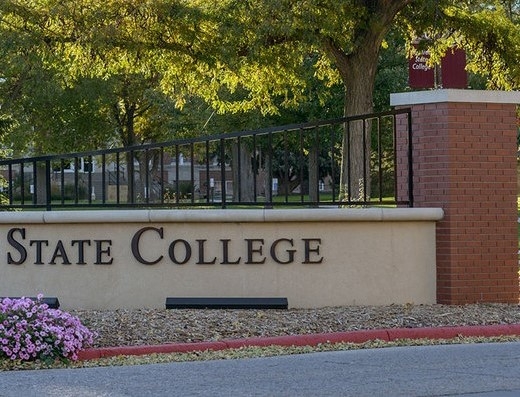You have /5 articles left.
Sign up for a free account or log in.

Chadron State College
Rural, regional colleges are economic and cultural engines for the communities they serve. But these institutions receive little public attention for their contributions and are often only noticed when they are financially or operationally challenged, said Kevin McClure, an associate professor of higher education at the University of North Carolina at Wilmington.
“Research on these colleges has often lagged compared to other types of institutions. Because of the dearth of information and the lack of good research out there, a fair amount of disinformation has proliferated,” McClure said. “The result has often been a deficit-based way of thinking about these institutions -- one that becomes preoccupied with their challenges and fails to appreciate their many contributions.”
McClure has studied regional colleges for nearly a decade. So have Cecilia Orphan at the University of Denver, Alisa Hicklin Fryar at the University of Oklahoma and Andrew Koricich at Appalachian State University. Together, the four professors direct the Alliance for Research on Regional Colleges, a brand-new research hub that aims to highlight the importance of regional public institutions to students and communities.
The alliance was born out of a one-time project -- which was recently published as the alliance’s first report -- that quickly turned into a long-term effort.
“In a relatively short amount of time, we had to come up with a name and build a website and work with graphic designers and developers and come up with a logo,” McClure said. “It’s been probably one of the most challenging seven months but also one of the most professionally rewarding seven months of my career.”
The alliance plans to publish additional reports and white papers, build accessible data sets, and advocate for regional colleges. The team also hopes that additional research partners and junior scholars will join the alliance and develop an interest in studying regional institutions.
Beyond that, the alliance’s future plans are still being determined.
“We’re kind of building the ship as we sail it,” McClure said.
The alliance’s first report, released Tuesday, examines the contributions of regional public colleges to rural communities.
These institutions sustain local economies, train workers for high-demand local industries, help build out public health infrastructure and provide community access to education.
Many regional public colleges were established to fill job shortages in professions such as teaching or nursing, and they are still needed for those same reasons, the report said. The top degrees awarded at regional, rural colleges align with the predominant industries in rural areas, such as education, health, business, hospitality and tourism, and natural resource management.
During the COVID-19 pandemic, regional colleges’ contributions to public health have been essential, according to the report. Rural, regional institutions often serve counties located in medically underserved areas with few physicians relative to the population and whose residents often have poor to fair health outcomes.
"Many rural public colleges educate nurses and people entering necessary healthcare professions, and some have clinics providing free or low-cost care. Rural public colleges have responded to the COVID-19 challenge, providing access to testing and helping to disseminate public health information related to vaccines," the report said.
Regional colleges also face significant challenges that have been worsened by the pandemic.
“Despite being an essential postsecondary education access point, rural public colleges face challenges that predate the pandemic, and the financial and public health fallout from COVID-19 has only exacerbated these challenges,” the report said. “Rural public colleges also face questions over their relevance, with policy makers at times suggesting mergers or closures of these institutions. At the same time, rural public colleges and the communities they serve are too often ignored in policy discussions.”
Regional public institutions are not wealthy and typically have small endowments and consistently lower revenues than research and urban universities. Low operating budgets and small financial reserves have made it difficult for these institutions to weather the revenue shortages and added costs of the pandemic.
The report authors suggest several policy recommendations that would benefit rural regional institutions. The first: basing future stimulus funding on student head count, not full-time-equivalent enrollment.
“Full-time-equivalent enrollment has been the standard way of measuring the number of students at an institution for some time, and the problem is that that figure often undercounts the number of students that are at these types of institutions, many of which are serving part-time students,” McClure said.
For example, during the 2018-19 academic year, Texas A&M University Commerce counted 12,411 undergraduate students, according to data from the National Center for Education Statistics. In the same academic year, reported full-time-equivalent undergraduate enrollment at the public university was 9,162 -- a 42 percent difference.
The second COVID-19 stimulus bill, which was passed at the end of last year, fulfills this recommendation in part. The bill will divvy up relief funds for colleges based on both full-time-equivalent enrollment and total student head count.
In reality, institutions spend similar resources to educate part-time students as they do full-time students, McClure said.
The authors also suggest providing $1,000 grants to Pell Grant-eligible students who attend rural public colleges so they can purchase laptops and participate in remote learning.
“Through my research, I learned that rural students are more likely to rely on smartphones and do not have access to computers or laptops,” Orphan said in an email.
The alliance’s report also included several policy proposals aimed at helping the institutions reinvest in their communities, including incentives for cooperative partnerships between rural hospitals, clinics and rural public colleges; modifications to rural business development grants; changes to the TEACH Grant program to incentivize teachers to work in rural communities; and loan forgiveness for graduates of health science programs who work in rural communities.
“These are not ivory tower institutions that are exclusive and set apart,” McClure said. “Rather, these are institutions that are enmeshed in the local community.”








